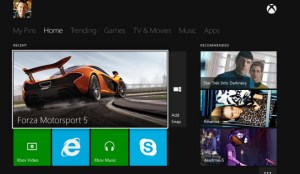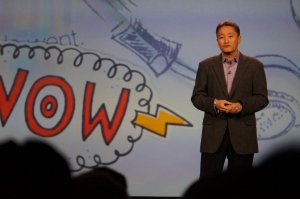GamesBeat: Robert, do you think you have more challenges than someone like Netflix, which sometimes consumes half of the Internet’s bandwidth streaming movies out? If you guys ever got really big, streaming games in a brute-force manner is not going to be a scalable enterprise.
Stevenson: Yeah, there are many challenges facing us as far as scale. The difference between Netflix and our cloud context is that Netflix has time to set up a file and stream a file. We don’t have that luxury. It has to be a realtime response. We have to take it and process it and turn it around in milliseconds. We don’t have time to compress and make the most efficient use of the output. We can’t be as efficient in terms of bandwidth utilization.
Sometimes you unwrap a challenge and solve one thing, and something new comes up. As the local processing power and screen fidelity of devices, particularly mobile devices, gets better, your needs for what you want to bring downstream get higher. Again, the trends are moving in the right direction. Consumers have shown an appetite for streaming movies and music in abundance. If you look at the graphs, consumption is off the chart. We just have to solve the technology and get it done right.
GamesBeat: Albert, it seems like your challenge is to find a killer app for Kinect as well. You have the advantage of having it in the box now, but it also makes your box more expensive. People want to know what Kinect is going to deliver for them.
Penello: I don’t think of Kinect as an accessory to the Xbox One, the way it was with the 360. I think about it more as an integral part of the platform. With that, the things that we do around voice and identity. I’m sure you’ve played with it, where you can walk into a room and it recognizes you. That’s a pretty killer app. Or I can change channels and switch between applications with my voice. That’s a pretty killer app.
You talked about the cloud. We’re going to have a continuum of experiences. The system itself relies on Kinect. I think we differentiate there. We’re going to continue to build core-gaming-specific content. It’ll also be interesting to see what developers do when they can rely on it in every box. Kinect-enhanced games, like what Battlefield did with leaning, will be more the norm. From the system-level functions to enhancing core games, I think we’re in a good position.
GamesBeat: Jami, I think about how you keep a brand going in the mobile space as one of your challenges. Such a diversity of games have been rising to the top very quickly. You have Angry Birds getting close to two billion downloads, but now there’s Clash of Clans and Candy Crush Saga as well. It seems like the top ranks of the mobile gaming world are changing a lot, still. I don’t know how you deal with that.
Laes: Sure, the top-grossing ranks have changed throughout the last year. There was a big genre migration toward puzzle games and casino games on the U.S. iOS lists, as well as build and battle games, where Clash of Clans is the biggest example.
For Angry Birds or any of our games at Rovio, we’re not thinking about building something for a couple of hundred days. We’re building an entertainment company for hundreds of years. That’s our vision. That’s why we’re building new kinds of experiences. We’re starting with Angry Birds Go, going to a new gameplay pattern, a new genre, going fully 3D, using a new business model. That’s a good example of what’s going to be coming from Rovio in the future, under the Angry Birds brand and new brands as well. It’s going to be a more balanced diet — birds, pigs, and vegetables, if you will.
Of course, you always need to keep delivering great quality content. That’s what we’ve been doing this year. We’ve had almost two billion views of our Angry Birds Toons, which we launched last year in March. That’s another way to keep the brand going. You don’t only think of how many launches of new games you have, but how many different kinds of entertainment experiences you’re offering. There’s no silver bullet. You just have to work hard and make sure that you have great content that keeps people engaged and entertained.
GamesBeat: Do we have any closing thoughts on our session here?
Laes: One of the key things to say is what Nate said first, that it’s a great time to be a gamer. It’s also a great time to be a developer. All these technologies and platforms and methods for distribution and discovery, the new audiences that developers and our games are finding — more and more people are getting into gaming.
Especially on mobile, which is close to my heart, we’re going to be seeing more and more clever mash-ups, where the game literacy bar is going to be raised, even for casual gamers. You’ll be able to combine elements from different genres and different types of games in a very casual way and create meaningful experiences that are going to be widely adopted by huge audiences. People are well educated in gaming already, both in the western world and particularly in Asia.
We’re going to see some great things, especially in mobile. Like we saw on CNN yesterday, four to seven percent of all technology spend is going to mobile and smartphone. That’s going to lead to a lot of spend on content and games for mobile as well.
Mitchell: Gamers should be excited for the year to come. Really, congratulations to Microsoft and Sony on launching the new consoles. It’s awesome to see those boxes get into living rooms and see players connecting in new ways. I agree that a killer app for Kinect, at least one of them, is the user recognition. It’s awesome.
Gamers are going to be excited about the new experiences that all the technology we’re talking about here will make possible, the opportunities it opens up for them, like virtual reality and cloud gaming. I’m excited to see what content creators do. That’s what we should all be excited for.
Penello: For us, we’re at the dawn of a new generation, having just launched the Xbox One. We learned so much through the years for 360 that we put into the development of Xbox One. The Xbox 360 still feels like a new product. When we shipped it in 2005, there were no tablets, no smartphones. Wireless Internet was barely in the home. There were no streaming video services. There was no HD video at all That was the world we lived in, in 2005. I can’t imagine what the world is going to look like 10 years from now.
Stevenson: It’s a great time to be in technology in general, in building these tools and using these tools and paving the road out to the future. I can’t wait to see what we’re going to be talking about next year.
VentureBeat's mission is to be a digital town square for technical decision-makers to gain knowledge about transformative enterprise technology and transact. Learn More









![Reblog this post [with Zemanta]](http://img.zemanta.com/reblog_e.png?x-id=28e29c56-b507-473b-98b9-b5c5f054b62a)
